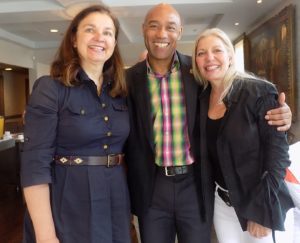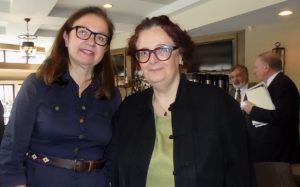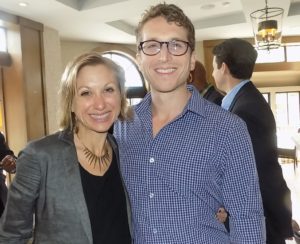African Art Museum Director Speaks in Georgetown
By • June 7, 2018 0 1630

Augustus Casely-Hayford, new director of the National Museum of African Art, came to Georgetown June 7 to speak at the George Town Club as part of Georgetown Media Group’s Cultural Leadership Breakfast Series.
He may be doing more than just visiting. Casely-Hayford (who goes by Gus) is in the “final stages” of purchasing a house on Dumbarton Street. “I feel very much like I’m coming home,” he said, comparing Georgetown’s ambiance to that of London’s Hampstead, where he lived before taking up the Smithsonian post in February.
A descendant of key figures in Ghana’s independence movement, Casely-Hayford told attendees how his parents, who moved to the U.K. in the 1950s, wanted their children to blend in as much as possible. Apart from the “racial abuse” in south London that the family faced, he spoke of a “sense of a loss of history.” His ancestral story wasn’t told in school and, when he visited the British Museum, he found that African objects were kept in a separate building.
One of the first objects to become part of the British Museum’s collection was an 18th-century drum that had come from West Africa to the American colonies on a slave ship, an example, said Casely-Hayford, of how African culture survived “against all odds.” The drum was part of the collection of Hans Sloane, a physician who acquired it in Virginia, where he had investments in tobacco plantations. (Sloane’s collection became the founding collection of the British Museum.)
Seeking connections to his African heritage, Casely-Hayford — who later got a Ph.D. from the University of London’s School of Oriental and African Studies — traveled extensively. In his remarks, he described trips to the Debra Dama church in Ethiopia and to the Sahara’s edge in Sudan. Visiting relatives in Ghana, he received a worn cloth, a family heirloom, as a gift, and came to understand how “history could be palpable” — that, as was explained to him: “We demonstrate our love and respect by using things.”
One of his guiding principles is the Zulu concept of Ubuntu — “I am, because of you” — which he heard Nelson Mandela speak about in London. In his work, for museums and as a writer, lecturer and broadcaster, Casely-Hayford has sought to overcome the centuries-long assault on and denigration of African culture, using it to build community not only among those of African descent but everyone. He recently published “Timbuktu,” a book on the Malian empire, which flourished prior to the European contact that eventually turned West Africa into the Gold Coast and launched the trans-Atlantic slave trade.
The connection between West Africa and gold will be explored in an exhibition opening Oct. 24 at the museum, “Good as Gold: Fashioning Senegalese Women,” also celebrating a gift of gold jewelry to the collection.
Now numbering some 12,000 objects, including works of contemporary art, the permanent collection was originally assembled by Warren Robbins, a State Department cultural attaché who opened the museum — the first U.S. museum solely devoted to African art — in 1964 in an A Street NE house where Frederick Douglass lived in the 1870s. “None of it is colonial plunder,” Casely-Hayford said. It has a “different kind of resonance.”
Responding to a request to name a favorite piece, Casely-Hayford cited a contemporary sculpture by Ghanian artist El Anatsui in which discarded bottle caps have been “woven” into a work resembling a traditional fabric. Contemporary African artists are “speaking to our particular time,” said Casely-Hayford, in their work addressing issues such as globalization, climate change and political, economic and religious divisions.
In contrast to the excellence of the museum’s collection, curators, conservators, library and archives, its mostly underground building on the Smithsonian Quadrangle — now more than 30 years old — is in need of refurbishment and repair. Gallons of water leaked in during the recent rainstorm, Casely-Hayford said.
To get the museum the resources and attention it deserves, he plans to be “kind of evangelical,” he said, “shouting out who we are.” Another goal is to reimagine the museum with digital tools.
The June 7 breakfast was the 27th in the series, currently sponsored by Bonhams, which will resume Sept. 13.

Gertraud Hechl of Bonhams, Augustus Casely-Hayford of the National Museum of African Art and Sonya Bernhardt of The Georgetowner. Photo by Robert Devaney.

Gertraud Hechl of Bonhams and Sarah Diligenti of Alliance Francaise. Photo by Robert Devaney.

Emma Stein and Ari Post. Photo by Robert Devaney.

